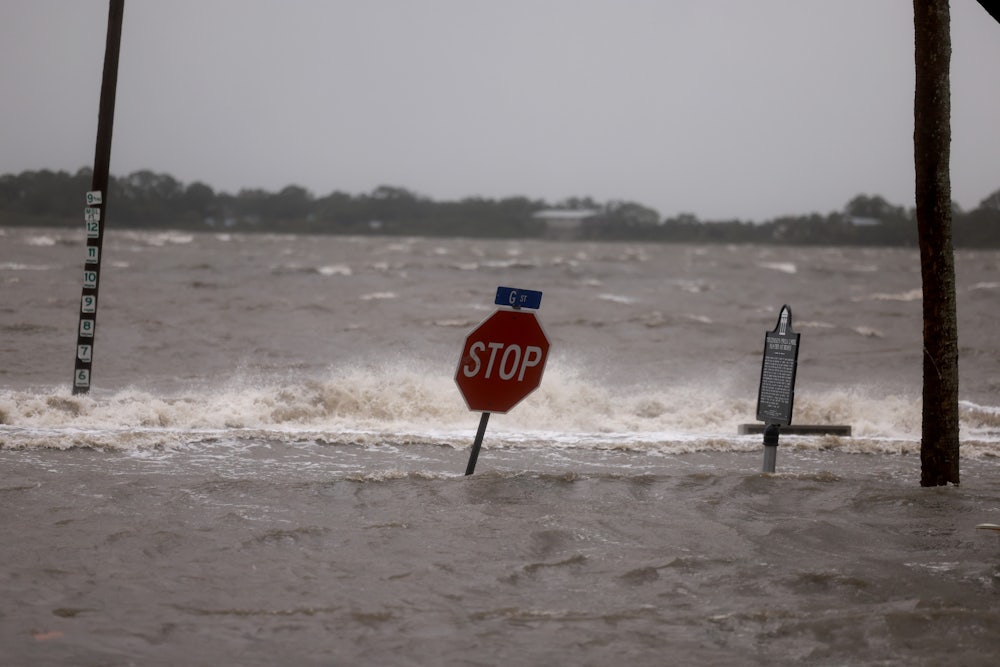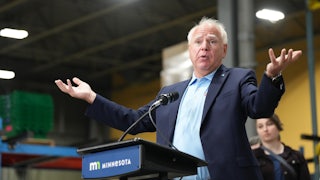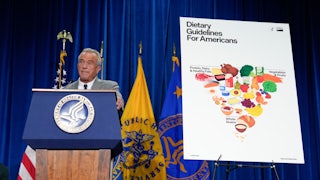Since touching down off Florida’s Gulf Coast Monday, Hurricane Debby has claimed four lives in the state, dumped more than a foot of rain across the Southeast, and left many fleeing tornadoes as temperatures in parts of the Sunshine State breached 110 degrees. As Debby lurches up the East Coast—depositing heavy rains as far north as Vermont—Floridians continue to grapple with a storm whose effects won’t be leaving them anytime soon.
Home insurance rates in Florida are among the highest in the nation, having increased by nearly 20 percent in 2023. The average homeowner there pays $10,996 per year; the national average is $2,377. Insurance rates have risen in no small part because of storms strengthened by climate change. Whereas Florida experienced roughly one billion-dollar disaster per year through the 1980s, the state can now expect four such events annually. Worsening weather has meant bigger payouts in Florida and also led to a dramatic, global rise in the cost of reinsurance—essentially, insurance for insurers, the cost of which companies pass on to their customers.
Florida Governor Ron DeSantis, meanwhile, has led the charge to erase references to climate change from state law. Florida’s State Board of Administration—which handles the state’s investments and retirement benefits, and where DeSantis serves as one of three board members—is now similarly barred from considering climate-related financial risk. That’s somewhat ironic considering that the SBA administers the beleaguered Florida Hurricane Catastrophe Fund, a $12.4 billion pot meant to reimburse insurers for their ever-mounting storm losses.
In Florida and elsewhere, the climate crisis promises to bring costly and cascading damage to homeowners, renters, and businesses. “Five years ago an insurance company might have said that your property was insurable. Now they’re saying it’s not,” explains Birny Birnbaum, an insurance expert and the executive director of the Texas-based Center for Economic Justice. “But you didn’t buy your property with a five-year horizon. You bought your property with a 10-, 30-, or 50-year horizon.” In other words, buyers who purchased property based on the expectation that their monthly payments would be within their budgets are suddenly coming up short. “That creates havoc for property owners,” Birnbaum said. Moreover, because mortgages are federally backed—by Fannie Mae, Freddie Mac, and Ginnie Mae—a worsening insurance crisis threatens to ripple out across the economy.
“As more and more people are forced to go without insurance—and as insurance companies leave markets—the risk of mortgage failure increases,” Birnbaum added. “Were there a major event that caused many mortgages in a particular region to fail, it would have deep implications for federal finances, not only in terms of dollars spent for disaster recovery but the cost of bailing out Fannie, Freddie, and Ginnie.”
While working- and middle-class Floridians struggle to afford housing and insurance coverage and rebuild after disaster strikes, the DeSantis administration has further showered the insurance industry with giveaways and appointments while placing much of the blame for the state’s growing crisis on their customers. A report published last year by the American Federation of Teachers, Hedge Clippers, Florida Rising, and the Center for Popular Democracy found that insurance industry donors gave DeSantis and his political action committee, Friends of Ron DeSantis, $3.9 million between 2018 and 2022. Those contributions included “more than $150,000 in one day from dozens of State Farm agents,” the report notes. “Including their donations to the Republican Party of Florida since January 1st, 2019 (days before DeSantis took his oath of office), campaign money from the insurance industry balloons to more than $9.9 million,” the report adds.
The problems with Florida’s insurance market have reached new heights during DeSantis’s tenure but aren’t altogether new. Major insurers began fleeing the state after Hurricane Andrew in 1992, when many of their competitors went bankrupt amid historic losses. Costly storm seasons in 2017 and 2022 saw more than a dozen other companies, like Farmers Insurance, pull out of the state too. In their place—encouraged by generous state incentives—smaller and sometimes shadier insurers have emerged, often concentrated in Florida and heavily dependent on reinsurance, which itself is becoming much more complex, speculative, and expensive. The state’s population has also continued to grow, including in risky, ritzy areas along the South Florida coast. That means there are more properties exposed to worsening damages and greater concentrations of risk for insurers that might be less equipped to weather it.
Between 2021 and 2022, seven Florida property insurers went bankrupt, leaving policyholders with outstanding claims with little recourse and massive bills. Those bankruptcies may be somewhat surprising given those firms had all received an “A” rating from an Ohio-based firm called Demotech Inc., a ratings agency meant to serve as an alternative to the likes of Standard & Poors and AM Best, which often refuse to rate upstart Florida insurers.
As a working paper from researchers at Harvard Business School published late last year found, more than 50 percent of Florida property insurers were rated by Demotech or other emergent agencies as of 2018. Between 2009 and 2022, researchers found, nearly 20 percent of companies that were rated financially solvent by Demotech ended up going under; 99.7 percent of all ratings given by Demotech were “A” ratings. (Demotech’s president and co-founder called the paper a “hit job” in an interview with Bloomberg, and denied that the company’s ratings are subpar.)
Florida has additionally created a series of state-backed institutions to fill the gaps left by private-sector insurers and provide a lifeline to the state’s all-important real estate sector. Citizens Property Insurance Corporation functions as Florida’s state-run insurer of last resort, with more than 1.2 million active policies. “Citizens” is overseen by a board of governors stocked by appointees of the governor, legislature, and key administrators. As James Baratta reported this week for The American Prospect, DeSantis’s two most recent appointments to the Citizens board—real estate magnate Carlos Beruff and gambling executive Jamie Shelton—both maxed out contributions to his failed presidential campaign. DeSantis’s previous appointments to the Citizens board have had close ties to the insurance industry. Previous board member Jilian Hasner was the president and CEO of an educational nonprofit that received donations from State Farm and Peoples Trust. Property casualty insurer Brown & Brown was a donor, as well, and the company’s executive vice president Matt Montgomery sat on the nonprofit’s board. Another DeSantis appointee, Nelson Telmarco, himself served on the board of Cimarron Insurance Company Inc., at the time licensed to do business in Florida.
Depopulating Citizens—moving customers onto private plans—and driving up its rates have been key priorities for Florida’s private insurers, as such changes would limit the appeal of lower-cost competition and create opportunities to snap up customers coming off Citizens. As it has periodically over the last several years, the company is currently in a new phase of off-loading hundreds of thousands of its policies to the private market, aiming—per Citizens CEO Tim Cerio—to get its total numbers down to below one million. This week, Citizens also requested approval of a 13 percent rate hike from the Florida Office of Insurance Regulation, though it said it should raise rates by almost 93 percent in order to be “non-competitive” with private insurers. Per state law, customers Citizens wants to take off its books are obliged to accept a new policy so long as its premiums are no more than 20 percent above what Citizens charges. Depopulation drives, then, could mean a windfall for more expensive private insurers—and escalating costs for homeowners, as well as renters whose landlords pass those costs down to them.
Florida, of course, has its own interest in getting Citizens to shed policyholders too. “There’s been an ebb and flow between Citizens and the private market. Insurers come in, and they pull back out,” says Zac Taylor, a professor at Delft University of Technology who studies climate risk and the insurance sector, with a focus on Florida. “We see a lot of risk back on the state’s books relative to a few years ago. If you step back and look over the last 10 to 15 years, there was a concerted effort to move risk from the state onto private insurance books.”
Standard property insurance policies notably do not include flood insurance, which—although customers can opt for private coverage—is provided at subsidized rates through the National Flood Insurance Program, administered by the Federal Emergency Management Agency. That program has raised its rates in recent years, and just 13 percent of Florida households are covered.
Property insurance reforms undertaken during DeSantis’s time in office, critics argue, have offered little more than giveaways to insurers. Legislation passed in 2022 created a $2 billion reinsurance fund, serving as a taxpayer-funded reinsurer of last resort, as well as a $1 billion subsidy allowing companies to more easily purchase reinsurance. In line with insurance industry talking points arguing that fraud and excessive litigation are core causes of rising rates, the measures also eliminated certain consumer protections, including a long-standing provision that offered state support for policyholders to hire attorneys to sue insurers who refused to honor claims.
Despite skyrocketing insurance costs, flashy apartment towers branded by the likes of Porsche and Aston Martin continue to crop up along the South Florida coast, still one of the world’s hottest luxury real estate markets. As one high-end real estate agent in Miami told the hosts of Bloomberg’s Odd Lots podcast recently, the people shelling out tens of millions of dollars a pop there “are so wealthy” that “if their insurance premium is $90,000 a year as opposed to $60,000 a year, they may gripe about it, but I have not seen a buyer not proceed with a transaction because of an insurance quote.” The ultrawealthy denizens of Biscayne Bay—including the likes of Rick Ross and Ken Griffin—can pay upward of $600,000 a year.
Insurance troubles aren’t unique to Florida, of course. State Farm last year announced that it would stop underwriting new policies in California as costs mount from destructive wildfires. Derechos, tornadoes, distorted ratemaking formulas, and passive regulators are helping drive up costs in the center of the country, leaving Oklahomans to pay some of the country’s highest premiums. Florida’s situation, though—a brew of climate-denying elected officials taking big donations from insurance executives; fabulously rich, tacky, and hungry real estate development; massive climate risk; and millions of ordinary people struggling to make ends meet—offers an especially chilling preview for what’s to come as the climate crisis crashes into a country where economic stability is premised on property ownership.








